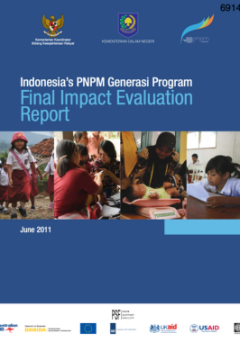Ditapis dengan

Indonesia's PNPM Generasi Program Final Impact Evaluation Report
- Edisi
- 1
- ISBN/ISSN
- -
- Deskripsi Fisik
- PDF, 168 Halaman
- Judul Seri
- Ebook
- No. Panggil
- 362.5 KEM.I
- Edisi
- 1
- ISBN/ISSN
- -
- Deskripsi Fisik
- PDF, 168 Halaman
- Judul Seri
- Ebook
- No. Panggil
- 362.5 KEM.I

Program Penanggulangan Kemiskinan Kabinet Indonesia Bersatu II
- Edisi
- 1
- ISBN/ISSN
- -
- Deskripsi Fisik
- PDF, 53 Halaman
- Judul Seri
- Ebook
- No. Panggil
- 362.5 KEM.P
- Edisi
- 1
- ISBN/ISSN
- -
- Deskripsi Fisik
- PDF, 53 Halaman
- Judul Seri
- Ebook
- No. Panggil
- 362.5 KEM.P

Petunjuk Pelaksanaan Verifikasi/Validasi Data Rumah Tangga Dalam Mekanisme …
- Edisi
- 1
- ISBN/ISSN
- -
- Deskripsi Fisik
- PDF, 84 Halaman
- Judul Seri
- Ebook
- No. Panggil
- 362.5 WID.P
- Edisi
- 1
- ISBN/ISSN
- -
- Deskripsi Fisik
- PDF, 84 Halaman
- Judul Seri
- Ebook
- No. Panggil
- 362.5 WID.P

Perencanaan Penanggulangan Kemiskinan Berbasis Data Mempertajam Intervensi …
Karakteristik dan perkembangan kemiskinan di Indonesia dewasa ini mengharuskan adanya kebijakan yang lebih sistematik, terpadu dan menyeluruh dalam penanganannya. Khususnya melalui sinergi antara pemerintah pusat, pemerintah daerah dan seluruh pemangku kepentingan lainnya. Kebijakan itu juga harus dapat diarahkan kepada pengurangan beban pengeluaran dan peningkatan pendapatan masyarakat miskin …
- Edisi
- 1
- ISBN/ISSN
- -
- Deskripsi Fisik
- PDF, 71 Halaman
- Judul Seri
- Ebook
- No. Panggil
- 362.5 TNP.P

How Does Parental Income Affect Child Labor Supply? Evidence from The Indones…
Drawing on the substitution axiom formulated by Basu and Van (1998) this study examines the nature of relationship between parental income and child labor supply in Indonesia. To estimate such relationship, we are benefited by panel data from the last two waves of Indonesia Family Life Survey (2007 and 2014). We tackle the potential endogeneity in parental income by controlling for parental fix…
- Edisi
- Working Paper 2 - 2018
- ISBN/ISSN
- -
- Deskripsi Fisik
- PDF, 30 Halaman
- Judul Seri
- Working Paper
- No. Panggil
- 362.71209598 SAT. H

Social Assistance for The Elderly: The Role of The Asistensi Sosial Lanjut Us…
Indonesia has undergone a demographic transition since the 1970s that has led to significant changes in the population age structure. Life expectancy increased from 45 years to 67 years. The number of elderly people (60 years and above) rose from about 5 million in 1970 to 18 million in 2010, and is projected to increase to over 80 million by 2050. The economic situation of the elderly is pr…
- Edisi
- TNP2K Working Paper 14 - 2014
- ISBN/ISSN
- -
- Deskripsi Fisik
- PDF, 52 Halaman
- Judul Seri
- Working Paper
- No. Panggil
- 361.1 ADI. S

Leading Indicators of Poverty in Indonesia: Application in The Short-Term Out…
Development indicators operate very dynamically in line with the government’s program and policy response. The government, therefore, needs an estimate of the poverty rate for a specific period in line with the development of its constituent indicators. The rate is required by the government to ensure the implemented policy can achieve the target according to the plan. Given the available ind…
- Edisi
- Working Paper 49-2020
- ISBN/ISSN
- -
- Deskripsi Fisik
- PDF, 36 Halaman
- Judul Seri
- Working Paper
- No. Panggil
- 362.509598 NUG. L

Towards Spatial Poverty Targeting: Identification of Poverty Clustering in In…
The Government of Indonesia is facing a new challenge in tackling poverty since the pace of the fall in the poverty rate has been slowing over the five years to 2020. To date, poverty alleviation programs implemented by the Government of Indonesia have been limited to large administrative areas such as the district (kabupaten) level. For this study, we combined the Poverty Livelihood Map of …
- Edisi
- Working Paper 53-e - 2020
- ISBN/ISSN
- -
- Deskripsi Fisik
- PDF, 22 Halaman
- Judul Seri
- Working Paper
- No. Panggil
- 362.509598 CAH. T

Priority Regions for Prevention of Stunting
One aspect of Indonesia’s health profile that still needs improvement is stunting. In 2018 Indonesia had one of the highest prevalence rates for stunting in the world at 30.8 percent. To achieve the National Medium-Term Development Plan 2015-2019 (Rencana Pembangunan Jangka Menengah Negara: RPJMN) target of a 28 percent stunting rate, in 2018 the government set priority areas for stunting pre…
- Edisi
- Working Paper 47 - 2019
- ISBN/ISSN
- -
- Deskripsi Fisik
- PDF, 28 Halaman
- Judul Seri
- Working Paper
- No. Panggil
- 362.196398 ADJ. P

Harmonisation of Susenas and Riskesdas
To succeed in implementing programs to reduce the number of stunted children, accurate and timely data and information are required to serve as the basis for target and goal setting. The use of Riskesdas (Riset Kesehatan Dasar: Basic Health Research) is highly important to generate indicators on the Indonesian people’s health status and monitor the success of various government programs in th…
- Edisi
- Working Paper 43 - 2019
- ISBN/ISSN
- -
- Deskripsi Fisik
- PDF, 20 Halaman
- Judul Seri
- Working Paper
- No. Panggil
- 362.109598 ADJ. H
 Karya Umum
Karya Umum  Filsafat
Filsafat  Agama
Agama  Ilmu-ilmu Sosial
Ilmu-ilmu Sosial  Bahasa
Bahasa  Ilmu-ilmu Murni
Ilmu-ilmu Murni  Ilmu-ilmu Terapan
Ilmu-ilmu Terapan  Kesenian, Hiburan, dan Olahraga
Kesenian, Hiburan, dan Olahraga  Kesusastraan
Kesusastraan  Geografi dan Sejarah
Geografi dan Sejarah